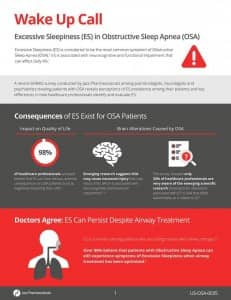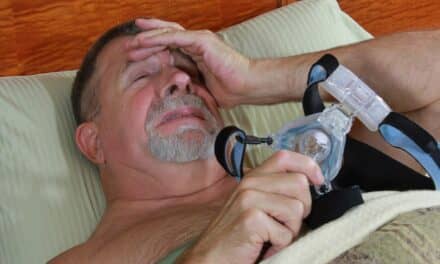A new survey, created and sponsored by Jazz Pharmaceuticals plc, finds that the vast majority (97.6%) of responding physicians are aware of the negative effects that excessive sleepiness (ES) can have on obstructive sleep apnea (OSA) patients’ quality of life, while less than a third (29%) of physicians are very aware of emerging scientific research linking OSA to serious brain alterations that affect wakefulness.
OSA is a prevalent disease in which excessive sleepiness is a major presenting complaint in many cases. Recent scientific research suggests that in some cases, OSA can lead to brain alterations that increase sleepiness. These alterations may be independent of airway therapies, including continuous positive airway pressure (CPAP).1-6 Evidence suggests that excessive sleepiness may result from neuronal injury caused by OSA. In animal studies, chronic intermittent hypoxia and fragmented sleep caused loss of neurons in wakefulness-promoting regions of the brain. Structural changes in gray and white matter have been associated with reduced neurocognitive performance and compromised neuronal connectivity in patients with OSA. CPAP is the standard of care in the management of symptoms of moderate to severe OSA. Diagnosis of excessive sleepiness in OSA is based on a clinical assessment, which must be made by the treating physician after airway treatment is implemented and all other causative disorders have been ruled out, including other untreated sleep disorders, mental disorders, or the effects of medication. Excessive sleepiness in OSA is associated with adverse health consequences, including neurocognitive and functional impairment.7,8
“Though significant progress is being made across medical disciplines to identify ES in patients with OSA, research shows that effects of this condition are far more detrimental to the brain than previously known,” says Jed Black, MD, senior vice president, Sleep and CNS Medicine at Jazz Pharmaceuticals and adjunct professor, Stanford Center for Sleep Sciences and Medicine, in a release. “Jazz is committed to ongoing research, education, and advocacy on behalf of these patients and the sleep community to share insights that may lead to advances in treatment and medical practice.”
Findings from the non-validated survey also highlight opportunities to standardize identification and evaluation of ES symptoms across specialties. The majority of pulmonologists (82%) identified that they most often use the Epworth Sleepiness Scale (ESS), while the majority of psychiatrists (76%) reported primarily using informal questions, and neurologists were more evenly divided between the two methods they could select in the survey (54% using ESS and 68% using informal questions). In addition, 44.6% of pulmonologists reported evaluating their patients for ES symptoms every 6 months, while 49.1% of neurologists reported evaluating their patients every 3 months and psychiatrists reported evaluating their patients every 1-to-3 months (33%, one month; 47.5%, three months), possibly reflecting the frequency of office visits for the different specialists.
Richard K. Bogan, MD, FCCP, FAASM, associate clinical professor at the University of South Carolina School of Medicine and chief medical officer at SleepMed, says in a release, “This survey provides meaningful new insights into how we, as healthcare providers/clinicians, are evaluating patients with OSA-related ES and ultimately, partnering with them to improve health. As more scientific evidence emerges around the neuronal injury occurring due to OSA and the potential neurocognitive effects of ES, it’s imperative that pulmonologists, neurologists, and psychiatrists understand the impact ES can have on patients’ lives.”
This survey was created and sponsored by Jazz and administered by SERMO. Participants in the 10-question self-administered online SERMO non-validated survey included a nationally-representative sample of 476 neurologists, pulmonologists, and psychiatrists from across the United States who provide treatment to patients with OSA. They were surveyed on key topics in excessive sleepiness and obstructive sleep apnea. The study was conducted from March 30-31, 2018 using SERMO’s RealTime platform. Bogan is a paid consultant for Jazz Pharmaceuticals.
References
1. Zhou J, Camacho M, Tang X, Kushida CA. A review of neurocognitive function and obstructive sleep apnea with or without daytime sleepiness. Sleep Med. 2016;23:99-108.
2. Zhu Y, Fenik P, Zhan G, et al. Selective loss of catecholaminergic wake active neurons in a murine sleep apnea model. J Neurosci. 2007;27(37):10060-71.
3. Zhu Y, Fenik P, Zhan G, Xin R, Veasey SC. Degeneration in arousal neurons in chronic sleep disruption modeling sleep apnea. Front Neurol. 2015;6:109.
4. Joo EY, Tae WS, Lee MJ, et al. Reduced brain gray matter concentration in patients with obstructive sleep apnea syndrome. Sleep. 2010;33(2):235-41.
5. Lal C, Strange C, Bachman D. Neurocognitive impairment in obstructive sleep apnea. Chest. 2012;141(6):1601-10.
6. Xiong Y, Zhou XJ, Nisi RA, et al. Brain white matter changes in CPAP-treated obstructive sleep apnea patients with residual sleepiness. J Magn Reson Imaging. 2017;45(5):1371-8.
7. Garbarino S, Lanteri P, Durando P, Magnavita N, Sannita WG. Co-morbidity, mortality, quality of life and the healthcare/welfare/social costs of disordered sleep: a rapid review. Int J Environ Res Public Health. 2016;13(8).
8. Strohl KP, Brown DB, Collop N, et al. An official American Thoracic Society Clinical Practice Guideline: sleep apnea, sleepiness, and driving risk in noncommercial drivers. An update of a 1994 Statement. Am J Respir Crit Care Med. 2013;187(11):1259-1266.






Dear ewerybody
Did anyone think about possibility, that OSA and sleep apnea are consequences thalamus injury (autoimu. or circulatory)? Also, it is necessary more efort on research main cose of OSA, not only pay attention on consecuences. I think mask for mouth and nose is not the best solution, because pending mandibula and open moth, stimulates tongue fall down. Did anybody try support mandibula (and close mouth)and compare results with cipap or bipap on less sleep apnea betwen groups, with and without suppot mandibula? Best regards DJF